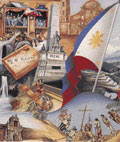 "Paradise Philippines" - The history of our beloved country:
"Paradise Philippines" - The history of our beloved country:The history of the Philippines is believed to begin with the arrival of the first humans in the Philippines by land bridges at least 30,000 years ago. The first recorded visit from the West is the arrival of Ferdinand Magellan on Homonhon Island, southeast of Samar on March 16, 1521. Permanent settlements in the island of Cebu were established with the expedition of Miguel López de Legazpi in 1565, and more settlements continued northward with the colonizers reaching the bay of Manila on the island of Luzon. In Manila they established a new town and thus began an era of Spanish colonization that lasted for more than three centuries.
The Philippine Revolution against Spain began in April of 1896, culminating two years later with a proclamation of independence and the establishment of the First Philippine Republic. However, the Treaty of Paris, at the end of the Spanish-American War, transferred control of the Philippines to the United States. U.S. colonial rule of the Philippines began in December 1899, with very limited local rule permitted beginning in 1905. Partial autonomy (commonwealth status) was granted in 1935, preparatory to a planned full independence from the United States in 1946. Preparation for a fully sovereign state was interrupted by the Japanese occupation of the islands during World War II.
With a promising economy in the 1950s and 1960s, the Philippines in the late 1960s and early 1970s saw a rise of student activism and civil unrest against the corrupt dictatorship of President Ferdinand Marcos who declared martial law in 1972. Because of close ties between United States and President Marcos, the U.S. government continued to support Marcos even though his administration was well-known for massive corruption and extensive human rights abuse. The peaceful and bloodless 1986 EDSA Revolution, however, brought about the ousting of Marcos (who fled to Hawaii on board a U.S. military helicopter, where he was exiled until his death) and a return to democracy for the country. The period since then, however, has been marked by political instability and hampered economic productivity.
 Facts About The Philippines - the country that we called "Paradise Philippines".
Facts About The Philippines - the country that we called "Paradise Philippines".